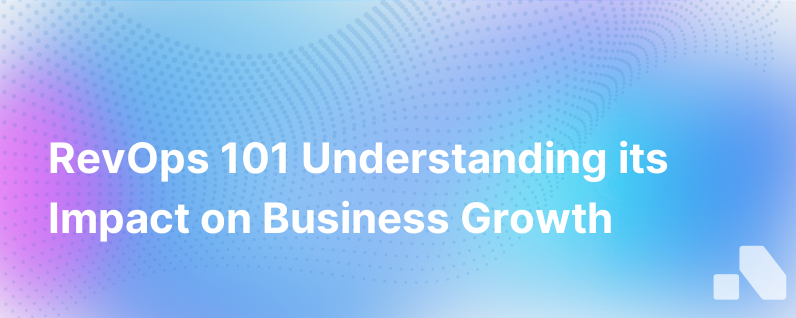Revenue Operations 101 What Is Revops And Why Is It Important
Published on December 26, 2023 by Sawyer Middeleer
In the rapidly evolving business landscape, the need for cohesion and streamlined operations across departments is more critical than ever. This is where Revenue Operations, colloquially known as RevOps, steps in as a transformative approach to business growth. RevOps is a relatively new term in the business lexicon, but it’s quickly become a pivotal strategy for organizations aiming to optimize their revenue potential.
Understanding Revenue Operations (RevOps)
RevOps is a business function that brings together marketing, sales, and customer success operations under a single umbrella. The goal is to drive growth through operational efficiency, removing silos that hinder interdepartmental collaboration and creating a unified approach to all aspects of revenue generation.
By orchestrating the three streams (marketing, sales, and customer success), RevOps streamlines processes, brings alignment to the organization’s revenue-generating engines, and provides visibility across the entire customer lifecycle. It is a holistic strategy that involves technology, processes, and data analysis to ensure that all teams are working together towards common business objectives.
Why is RevOps Critical for Organizational Success?
Alignment Across Teams
Historically, marketing, sales, and customer success have operated in separate silos, each focusing on stage-specific goals. This disjointed approach often results in misaligned targets and ineffective communication. RevOps dismantles these barriers, aligning goals and strategies across these functions, thus propelling a seamless revenue generation machine.
Enhanced Decision-Making
With data unification as a core tenet, RevOps enables organizations to make informed, data-driven decisions. A unified data platform offers clearer insights into the customer journey, identifying bottlenecks and areas for improvement. By leveraging comprehensive data, businesses can refine targeting strategies, predict customer behavior, and optimize sales funnels.
Operational Efficiency
Streamlining operational tasks reduces redundancy and increases productivity. RevOps focuses on automating repetitive tasks, thereby allowing teams to direct their efforts towards more strategic initiatives. Efficiency gains equate to cost savings, as well as improvements in speed and quality of operations.
Scalability
For companies eyeing growth, scalability is a concern. RevOps provides the framework for scalable business processes, ensuring that the organization can handle increased demand without sacrificing service quality or operational control. Companies can scale more effectively when processes are optimized and everyone is rowing in the same direction.
Increased Revenue and Profit
Ultimately, the coordination delivered by RevOps leads to increased revenue. Being intricately aware of the purchase cycle, customer needs, and pain points allows for a more strategic approach to cross-selling and upselling, thereby boosting customer value. In addition, a tight, seamless process reduces the cost of acquiring and serving customers, directly impacting the bottom line.
Implementing RevOps: Key Components
Adopting a RevOps approach requires an understanding of its key components: strategy, data, process, and tools.
Strategy
A strategic framework that outlines the collective objectives of marketing, sales, and customer success is the foundation of RevOps. This includes defining common goals, setting KPIs that reflect overarching business objectives, and building a culture of collaboration—eliminating competition between departments for credit in favor of shared success metrics.
Data
Data is the lifeblood of the RevOps framework, driving insights and action. RevOps involves integrating data sources from marketing automation, CRM software, customer feedback, and more, to create a 360-degree view of customer interactions and experiences.
Processes
Effective RevOps identifies and standardizes key business processes to ensure everyone adheres to the same practices and uses the same data sets. Processes around lead management, sales forecasting, customer onboarding, and retention are particularly critical in the RevOps model.
Tools and Technology
Tools that support RevOps need to enable automation, provide clear insights, and connect seamlessly to other business systems. The technology architecture should facilitate collaboration and information sharing, often involving an integrated CRM solution, marketing automation platforms, and analytics tools.
Challenges in RevOps Execution
While RevOps brings multiple benefits, implementing this model is not without challenges:
- Resistance to Change: Merging different teams and operations can meet resistance from team members accustomed to working independently.
- Technology Alignment: Ensuring the existing technology stack is integrated and aligned can be a complex undertaking requiring specialist skills.
- Data Integration and Quality: The data consolidation process may reveal issues with data quality and consistency that need to be resolved for accurate reporting and analysis.
Conclusion
RevOps emerges as an essential paradigm to foster sustainable growth in the competitive marketplace. It allows businesses to leverage collaboration, data integration, and streamlined processes to drive revenue efficiency and scalability.
By comprehensively understanding and adopting the strategic practices of RevOps, organizations can break down traditional operational silos, enhance decision-making, and achieve a continuous loop of growth that aligns with evolving business requirements. It positions companies not just to survive in the modern business environment but to thrive, maximizing their opportunities for revenue and impact.